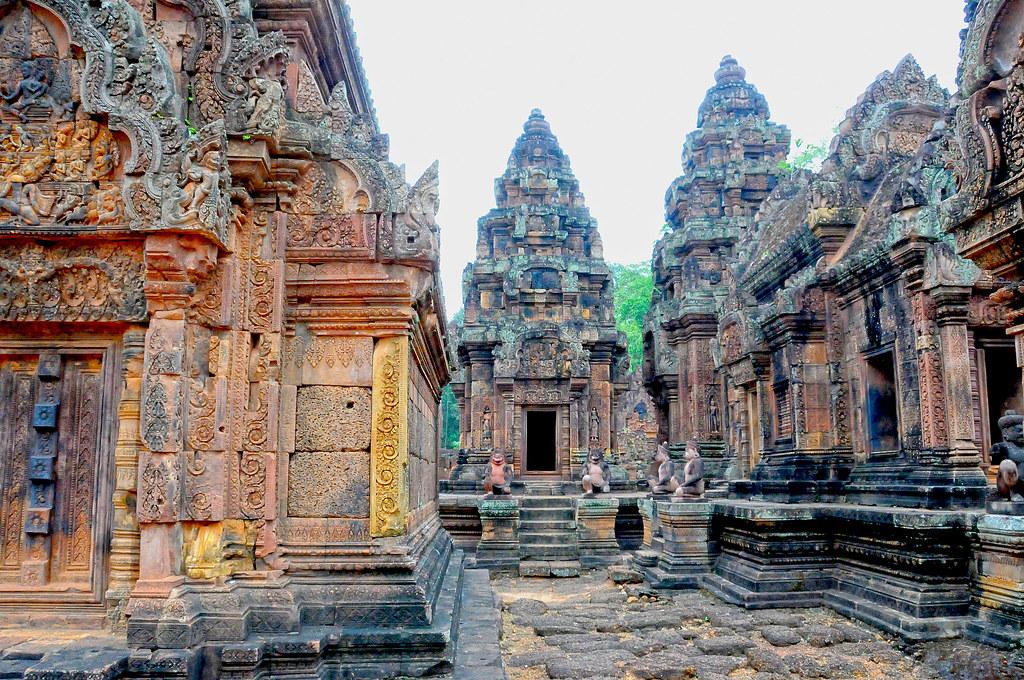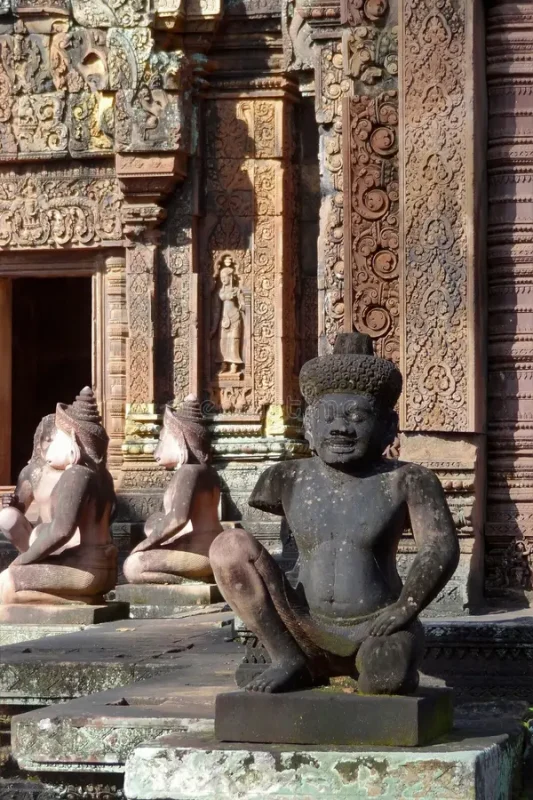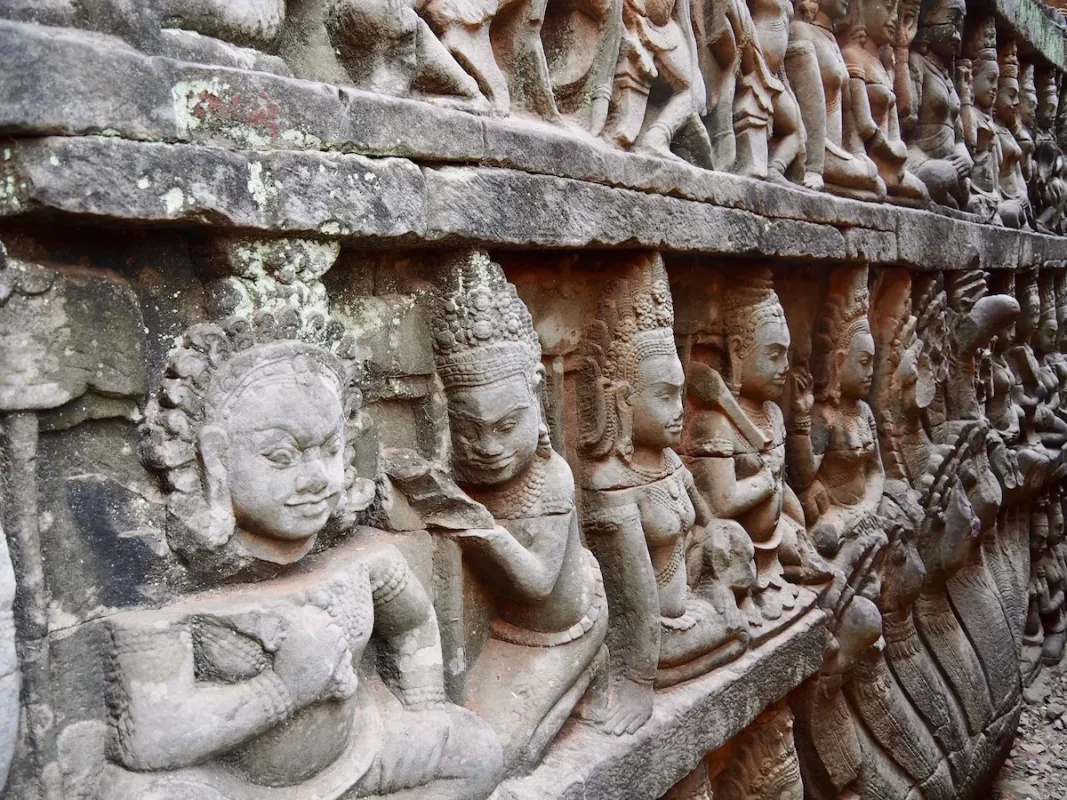Banteay Srei Temple: The Jewel of Khmer Art in Cambodia

Nestled amidst the lush jungles of Cambodia, Banteay Srei temple stands as a testament to the exquisite craftsmanship of the Khmer Empire. Often referred to as the “Citadel of Women” or “Lady Temple,” this 10th-century marvel is renowned for its intricate carvings, delicate sandstone architecture, and historical significance. Located near the iconic Angkor Wat complex, Banteay Srei is a must-visit destination for travelers exploring Cambodia’s rich cultural heritage. In this article, we’ll dive into the history, architecture, location, and tips for visiting Banteay Srei temple, ensuring you have all the details to plan your trip.
History of Banteay Srei Temple
Built in 967 AD during the reign of the Khmer Empire, Banteay Srei temple is one of Cambodia’s oldest and most unique temples. Unlike many of the grand structures in the Angkor region, it was not commissioned by a king but by two Hindu priests, Yajnavaraha and Vishnukumara, advisors to King Jayavarman V. Dedicated to the Hindu god Shiva, the temple reflects the religious devotion and artistic mastery of the era.
The name “Banteay Srei” translates to “Citadel of Women,” a moniker believed to stem from the temple’s petite size and the delicate, feminine quality of its carvings. Constructed during a period of peace and prosperity, this Cambodia temple showcases the pinnacle of Khmer architecture and artistry, setting it apart from larger temples like Angkor Wat or Bayon.
Rediscovered in 1914 by French archaeologists, Banteay Srei gained international attention after years of being hidden by the encroaching jungle. Its preservation and restoration efforts have since made it a UNESCO World Heritage Site, part of the greater Angkor Archaeological Park.
Architectural Brilliance of Banteay Srei
What makes Banteay Srei temple truly special is its architectural design. Unlike the monumental scale of Angkor Wat, Banteay Srei is smaller but compensates with unparalleled detail. The temple is constructed from red sandstone, a material that allowed artisans to carve intricate bas-reliefs with precision rarely seen in other Khmer temples.

The walls of Banteay Srei are adorned with elaborate carvings depicting scenes from Hindu mythology, including stories of Shiva, Vishnu, and the Ramayana. Floral motifs, mythical creatures like apsaras (celestial dancers), and guardian figures add to its charm. The temple’s lintels and pediments are particularly noteworthy, featuring some of the finest examples of Khmer art.
The layout of Banteay Srei follows a classic Khmer design: a central sanctuary surrounded by libraries and galleries, all enclosed within a moat and three concentric walls. Its compact size—measuring just 24 meters by 24 meters—enhances its intimate and refined aesthetic, earning it the nickname “Jewel of Khmer Art.”
Location and How to Get to Banteay Srei Temple
Banteay Srei temple is located approximately 25 kilometers (15.5 miles) northeast of Angkor Wat and 37 kilometers from Siem Reap, the gateway city to Cambodia’s temple region. Situated in the Angkor Archaeological Park in Siem Reap Province, it’s easily accessible for tourists exploring the area.
To reach Banteay Srei, visitors can hire a tuk-tuk, rent a bicycle, or join a guided tour from Siem Reap. The journey takes about 45 minutes by tuk-tuk or car, winding through rural villages and scenic countryside. The temple’s location, slightly off the main Angkor Wat circuit, offers a quieter and less crowded experience compared to its more famous neighbors.

Cultural and Historical Significance
Banteay Srei temple holds immense cultural and historical value. As one of the earliest temples in the Angkor region, it provides insight into the evolution of Khmer architecture and the religious practices of the time. Its dedication to Shiva reflects the prominence of Hinduism in the Khmer Empire before the shift toward Buddhism in later centuries.
The temple’s detailed carvings also serve as a historical record, preserving myths and traditions that have shaped Cambodian culture. For art historians and archaeologists, Banteay Srei is a treasure trove of information about 10th-century Khmer society.
Visiting Banteay Srei Temple: Tips and Information
- Best Time to Visit: The ideal time to explore Banteay Srei temple is during the cooler months of November to February, when temperatures are milder. Early morning visits offer pleasant weather and fewer crowds.
- Entry Fees: Admission to Banteay Srei is included in the Angkor Pass, which costs $37 for one day, $62 for three days, or $72 for seven days (as of March 2025).
- Dress Code: As a sacred site, visitors should wear modest clothing covering shoulders and knees.
- Facilities: A small visitor center near the temple provides basic amenities, but it’s wise to bring water and snacks, especially if exploring other temples in the area.
- Photography: The temple’s intricate carvings make it a paradise for photographers. Sunrise and late afternoon light enhance the red sandstone’s glow.
Why Banteay Srei Stands Out Among Cambodia Temples
While Angkor Wat and Ta Prohm often steal the spotlight, Banteay Srei temple offers a unique experience. Its smaller scale, detailed artistry, and serene setting provide a refreshing contrast to the grandeur of other Khmer temples. For those seeking to delve deeper into Cambodia’s history and architecture, Banteay Srei is an unmissable gem.
Conclusion
Banteay Srei temple is more than just a historical monument—it’s a masterpiece of Khmer architecture and a window into Cambodia’s ancient past. Whether you’re an art enthusiast, a history buff, or a traveler exploring the wonders of Siem Reap and Angkor Wat, this “Citadel of Women” promises an unforgettable experience. Plan your visit to Banteay Srei temple today and discover why it remains one of Cambodia’s most cherished treasures.



